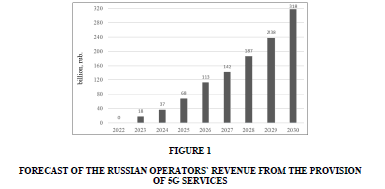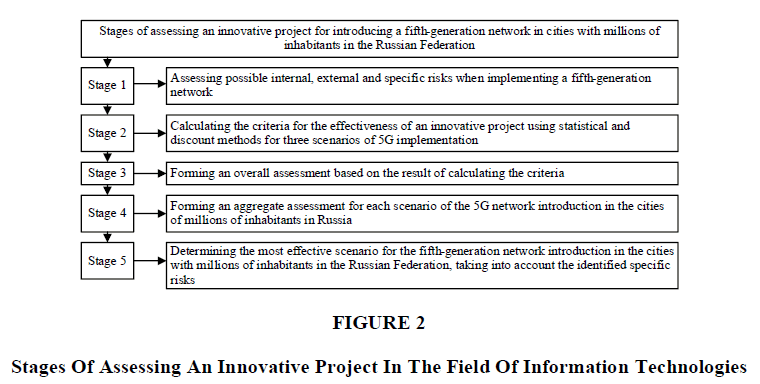Research Article: 2022 Vol: 25 Issue: 1
Methodology for assessing the effectiveness of the innovative project implementation in the field of information technology
Tatiana Yurievna Nikolenko, Moscow Aviation Institute (National Research University)
Lidiya Viktorovna Semina, Moscow Aviation Institute (National Research University)
Citation Information: Nikolenko, T. Y., & Semina, L. V. (2022). Methodology for assessing the effectiveness of the innovative project implementation in the field of information technology. Journal of Management Information and Decision Sciences, 25(1), 1-6.
Abstract
The study topic is relevant due to the growing need to implement innovative projects that increase the level of the national economy. The article describes the stages of analyzing an innovative project to implement 5G technology. The developed methodology takes into account both standard indicators of investment efficiency and the aggregate risk level. The advantage of the described methodology is the simplicity of calculations and the absence of the need for a large amount of initial information about the project.
Keywords
Innovative project; Analysis of the innovations effectiveness; Aggregate project assessment; Acceptability of indicators; Aggregate risk.
Introduction
Today, the possession of competitive advantages in the industry is a crucial factor for the successful development of any organization. Innovative projects and programs are essential for the development of many areas of science and technology, which also play an important role in the state scientific and technical policy (Bondarenko & Burdin, 2020; Burdina & Bondarenko, 2019; Kokurin, 2018). Activation of the process of introducing innovations is necessary to maintain high positions in the market, as well as the development of advanced technologies (Burdina & Bondarenko, 2020; Gorelov & Gyazova, 2018; Nikolenko, 2017, 2018).
Data and Methods of The Study
To achieve the country's economy growth, it is necessary to correctly evaluate each innovative project before its implementation. There are many methods of assessing the project effectiveness, thanks to which it is possible to calculate the feasibility of its development and further implementation to the wider communities. However, none of the assessment methods is universal, which requires the search for individual approaches (Bondarenko & Burdina, 2019; Vasilyeva & Krupnov, 2020; Kaloshina et al., 2018; Tarasova et al., 2017).
The main emphasis in this study is placed on the option of assessing a specific innovative project in the field of information technology. 5G technologies are considered as a necessary condition for creating a new, more competitive national economy in Russia (Kara & Savinskaya, 2018; Nosova et al., 2018; Sharma et al., 2018).
According to the results of a study by the Radio Research Institute (RRI), the revenues of Russian mobile operators from the implementation of an innovative project will reach about 320 billion rubles by 2030 (Figure 1).
Three possible scenarios for the introduction of a fifth-generation network in cities with millions of people in Russia, is being conducted:
1. Mainly autonomous development of the 5G network by each operator.
2. Intensive sharing of network infrastructure.
3. Emergence of a single infrastructure operator (Daneshmand, 2021; Pylaev, 2020)
(Figure 2).
Stages Of Assessing An Innovative Project In The Field Of Information Technologies
This approach will allow us to choose the most profitable scenario for implementing the project in terms of profitability with minimal threats of disruption.
Study Results
At the first stage, the possible risks of an innovative project, including specific ones, are analyzed (Burdina et al., 2020).
Experts assign the probability of its exclusion to each risk. Besides, within the aggregate, risks are distributed according to the degree of danger by assigning a score from 0 to 5 (Ilyichev, 2018). The calculation results for the first scenario of the project implementation are presented in Table 1.
| Table 1 Risk Assessment Of An Innovative Project Implementation |
||||
|---|---|---|---|---|
| Risk classification | Risk name | Probability of risk exclusion | Degree of risk danger | Weighted risk assessment (3x4) |
| 1 | 2 | 3 | 4 | 5 |
| Internal | Organizational | 0,8 | 1 | 0,8 |
| Technical | 0,4 | 3 | 1,2 | |
| Financial | 0,3 | 5 | 1,5 | |
| External | Socio-economic | 0,4 | 3 | 1,2 |
| Market | 0,5 | 3 | 1,5 | |
| Competitive | 0,2 | 4 | 0,8 | |
| Specific | Use of the technology only for state purposes | 0,7 | 1 | 0,7 |
| Inability to quickly fix problems | 0,6 | 2 | 1,2 | |
| General risk assessment | 8,9 | |||
Calculations are made in the same way for the other scenarios.
At the second stage of the analysis of the 5G technology introduction project, its economic efficiency is calculated using traditional methods for assessing investments (Ermakova et al., 2019; Nikolenko et al., 2018; Nikulina & Tarasova, 2019).
At the third stage, threshold values are set for each indicator of economic efficiency based on the scale developed by specialists. As a result of the correlation of the actual calculated values with the score scale, a universal assessment is formed (Matraeva et al., 2019; Nalivaychenko et al., 2020). Each criterion is assigned a weight. The final calculations for the first scenario are presented in Table 2.
| Table 2 Assessment Of The Acceptability Of The Criteria For The Economic Efficiency Of An Innovative Project |
||||||
|---|---|---|---|---|---|---|
| Indicator | Scale | Criterion weight | Calculation | |||
| Range of values | Score | Actual value | Corresponding score | Weighted assessment (4x6) |
||
| 1 | 2 | 3 | 4 | 5 | 6 | 7 |
| NPV, bln rub | 0-50 | 0 | 0,5 | 191,84 | 3 | 1,5 |
| 50-100 | 1 | |||||
| 100-150 | 2 | |||||
| 150-200 | 3 | |||||
| 200-250 | 4 | |||||
| 250-300 | 5 | |||||
| IRR, % | 0-5 | 0 | 0,1 | 24 | 4 | 0,4 |
| 5-10 | 1 | |||||
| 10-15 | 2 | |||||
| 15-20 | 3 | |||||
| 20-25 | 4 | |||||
| 30 and more | 5 | |||||
| PI | 0-0,4 | 0 | 0,2 | 1,23 | 3 | 0,6 |
| 0,4-0,8 | 1 | |||||
| 0,8-1,2 | 2 | |||||
| 1,2-1,6 | 3 | |||||
| 1,6-2,0 | 4 | |||||
| 2,0 and more | 5 | |||||
| DPP, years | 7-6,5 | 0 | 0,2 | 6 | 0 | 0 |
| 6,5-6 | 1 | |||||
| 6-5,5 | 2 | |||||
| 5,5-5 | 3 | |||||
| 5-4,5 | 4 | |||||
| 4,5-4 | 5 | |||||
| General criteria assessment | 2,5 | |||||
Calculations are made in the same way for the other scenarios.
At the fourth stage, experts decide on the nature of the advantage between the aggregate risk level and the acceptability of a group of investment efficiency criteria for an innovative project to implement a fifth-generation network. Experts assign a weight to each of these categories, which acts as a priority (Kafidov, 2019; Malaksiano, 2020). The calculation results for the considered innovation project are presented in Table 3.
| Table 3 Results Of The Assessment Of The Feasibility Of Implementing An Innovative Project For Each Scenario |
||||||
|---|---|---|---|---|---|---|
| Criterion | Scenario 1 | Scenario 2 | Scenario 3 | |||
| Weight | Value | Weight | Value | Weight | Value | |
| General risk assessment | 0,6 | 8,9 | 0,3 | 11,7 | 0,4 | 7,1 |
| General criteria assessment | 0,4 | 2,5 | 0,7 | 4,8 | 0,6 | 1,5 |
| Aggregate assessment | 6,34 | 6,87 | 3,74 | |||
At the fifth stage, based on the results obtained the most effective scenario for the introduction of a fifth-generation network.
Conclusion
As a result of the obtained analysis criteria for each of the scenarios, it is obvious that the most effective option for implementing a 5G network is intensive joint use of the network infrastructure by operators.
Overall, the proposed procedure for analyzing innovations simplifies the process of making managerial decisions about the start of financing, allowing people to make a choice in favor of one or another option based on only a single calculation criterion – an aggregate assessment. The stages described and tested in this study can be applied to assess projects in any industry.
References
Bondarenko, A. V., & Burdin, S. S. (2020). Strategic efficiency and strategic risk of high-tech products as factors of digital transformation. Economics and entrepreneurship, 10(123), 223-228.
Burdina, A. A., & Bondarenko, A. V. (2019). Mechanism of economic analysis of the complex effectiveness of the project for creating high-tech products. Economics of sustainable development, 3(39), 174-178.
Ilyichev, V. A. (2018). Biosphere compatibility: technologies for introducing innovations, cities that develop people. Moscow, Russia: Librocom, 240 p.
Kafidov, V. V. (2019). Innovations in the urban development of Russian cities. Moscow, Russia: LAP Lambert Academic Publishing, 60 p.
Kara, M. A., & Savinskaya, D. N. (2018). "5G" as an innovative generation of cellular communications, its development in Russia and abroad. Trends in the development of science and education, 44(2), 50-53.
Kokurin, D. I. (2018). Innovations in Russia: system-institutional analysis. Moscow, Russia: TransLit, 921 p.
Malaksiano, M. (2020). On managing innovative development within project-oriented companies. Danish Scientific Journal, 41, 56-62.
Matraeva, L. V., Vasyutina, E. S., & Korolkova, N. A. (2019). The model of assessment of quality and efficiency of managerial decisions by public management at various stages of state programs lifecycle. Quality - access to success, 170, 100-106.
Nalivaychenko, E.V., Kirilchuk, S. P., Skorobogatova, T. N., Cherniavaia, A. L., & Kaminskaya, A. O. (2020). Challenges of strategic planning at a modern enterprises. AD ALTA: Journal of interdisciplinary research, 10(1 S11), 43-46.
Nikolenko, T.Yu. (2017). Problems in organizing investment activity of a high-tech enterprise and ways to solve them. Economics and entrepreneurship, 8-4(84), 1033-1038.
Nikolenko, T.Yu. (2018). Research on the formation of the investment program of a high-tech enterprise. Bulletin of the University, 3, 115-124.
Nikulina, E., & Tarasova, E. (2019). Budget financing of investment projects at the high-technology industry enterprises: project implementation technology and risk mitigation. International Journal of Recent Technology and Engineering, 8(2), 5932-5935.
Nosova, S. S., Dubanevich, L. E., & Voronina, V. N. (2018). Digital technologies as instrument of growth of innovation of modern economy of Russia. Innovation and investment, 12, 9-14.
Pylaev, M. D. (2020). Prospects for the development of 5G in Russia. Modern innovations, 1(35), 18-20.
Tarasova, E. V., Nikulina, E. N., & Moskvicheva, N. V. (2017). Analysis of risk assessments methods of innovative projects. Revista Espacios, 38(49), 8-23.

